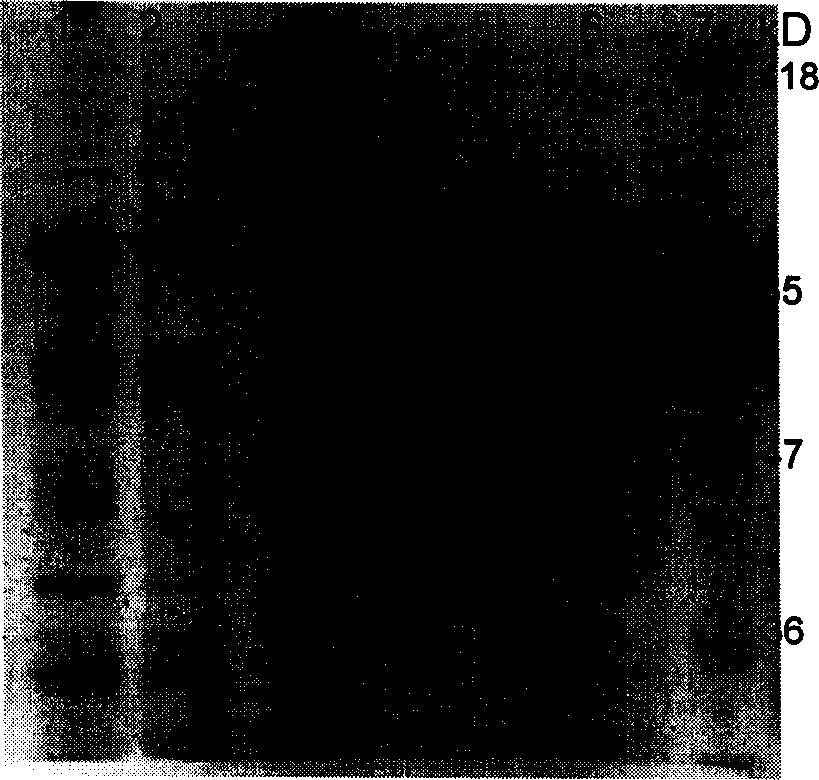Method of extracting lacto ferritin from transgene lactoferritin paddy rice
A lactoferrin and transgenic technology, which is applied to the preparation method of peptides, chemical instruments and methods, plant peptides, etc., can solve the problems of high NaCl content in products, affect the application of lactoferrin, and not meet actual needs, etc., to achieve enhanced functions Increased effect on food performance and feed quality, easy and fast extraction, cost savings
- Summary
- Abstract
- Description
- Claims
- Application Information
AI Technical Summary
Problems solved by technology
Method used
Image
Examples
Embodiment 1
[0028] Embodiment 1, the acquisition of the transgenic rice seed expressing lactoferrin:
[0029] The human lactoferrin gene (hLF) was synthesized by Shanghai Sangong, and the promoter was the rice Gt promoter. Gt and hLF were cloned in plasmid pCAM1300 to obtain pCAM1300-GT-hLF. pCAM1300-GT-hLF was transformed into rice varieties Xiushui 11 and Taipei 309 by Agrobacterium. hLF is controlled by the promoter Gt1 and can be expressed in rice seeds. Among the obtained 40 transgenic lines (2801-2840), two of them, lactoferrin 2824 and lactoferrin 2831, can express a relatively high level of lactoferrin and are used as materials of the present invention .
[0030] Of course, all transgenic lactoferrin rice seeds can be used as materials in the present invention.
Embodiment 2
[0031] Embodiment 2, the extraction of human lactoferrin in rice seeds, carry out the following steps successively: (the water referred to in this embodiment refers to the water not containing NaCl)
[0032] Method A:
[0033] Step 1. Add water or buffer solution to the rice seeds obtained in Example 1, mix and pulverize to form a wet powder; or directly pulverize the rice seeds obtained in Example 1, add water or buffer solution after pulverization and mix to form a wet powder. Powder; the buffer solution used is a buffer solution with a concentration of NaCl<0.1mol / L and a pH value of 6-7.5, and the temperature of the above pulverization process is kept below 70°C. The feed ratio of water or buffer solution to the rice seeds is 1 milliliter / gram.
[0034] Step 2. Mix and shake the above wet powder at a frequency of 250 rpm for 2-3 hours, centrifuge at 5000g for 10 minutes, and separate the precipitate and supernatant solution.
[0035] Step 3. Collect the precipitate obtai...
Embodiment 3
[0042] Embodiment 3, lactoferrin content and purity analysis:
[0043] The content and purity of the extracted lactoferrin can be analyzed by SDS-PAG. According to the general method of SDS-PAGE (Osper, F Brent, R Kingston, et al. Hardcover Molecular Biology Experiment Guide [M]. Beijing: Science Press, 1998, 334-338). The lactoferrin sample extracted in Example 2 was analyzed. Western analysis showed that the main protein band on the SDS-PAGE gel was lactoferrin. Densitometric scanning analysis found that it accounted for 40-60% of the total protein content, specifically as figure 1 Shown:
[0044] When selecting lactoferrin 2824 to carry out embodiment 2, 1 represents the lactoferrin extracted from lactoferrin rice 2824;
[0045] When selecting lactoferrin 2831 to carry out embodiment 2, 2 represents the lactoferrin extracted from lactoferrin rice 2831;
[0046] 3, 4, and 5 represent negative controls;
[0047] When selecting lactoferrin 2803 to carry out embodiment 2,...
PUM
 Login to View More
Login to View More Abstract
Description
Claims
Application Information
 Login to View More
Login to View More - R&D
- Intellectual Property
- Life Sciences
- Materials
- Tech Scout
- Unparalleled Data Quality
- Higher Quality Content
- 60% Fewer Hallucinations
Browse by: Latest US Patents, China's latest patents, Technical Efficacy Thesaurus, Application Domain, Technology Topic, Popular Technical Reports.
© 2025 PatSnap. All rights reserved.Legal|Privacy policy|Modern Slavery Act Transparency Statement|Sitemap|About US| Contact US: help@patsnap.com

